 |
by Ian Carlos Campbell on (#6ZSV1)
Honda is preparing to announce its first electric motorcycle with fast charging, based on a new teaser video the company shared on Instagram. The video shows off the new e-motorcycle on test rides in Europe and teases the date, September 16, when Honda will presumably introduce it. Plans to expand Honda's lineup of electric motorcycles have been in the works since at least 2022, when the company announced it would release "10 or more" e-motorcycles by 2025.The new motorcycle is under a wrap of black and white camouflage in the video, but Electrek writes that it shares a striking resemblance to the "EV Fun Concept" motorcycle Honda introduced at EICMA 2024, a motorcycle trade show in Milan. At the time, Honda said the boxy concept was designed to offer "performance equivalent to a mid-sized internal combustion engine (ICE) motorcycle" and be compatible with CCS2 quick chargers, an EV fast charging standard in Europe. It also has "a cruising range of over 100km," according to Honda.HondaLeaning on fast charging is one way the company could address possible range issues on the motorcycle. An electric motorcycle naturally offers less room for batteries than electric cars do. Honda's video doesn't get into any of those nitty gritty details, so we'll have to wait until September 16 to know for sure.One thing that does seem certain is the e-motorcycle's regional availability. Based on the fact the video was shared on Honda's UK Instagram page and specifically mentions it was "tested on European streets," it seems highly unlikely the motorcycle will be available outside of Europe and the United Kingdom.This article originally appeared on Engadget at https://www.engadget.com/transportation/evs/honda-teases-its-first-full-size-e-motorcycle-with-fast-charging-185116652.html?src=rss
|
 Engadget is a web magazine with obsessive daily coverage of everything new in gadgets and consumer electronics
Engadget is a web magazine with obsessive daily coverage of everything new in gadgets and consumer electronics
| Link | https://www.engadget.com/ |
| Feed | https://www.engadget.com/rss.xml |
| Copyright | copyright Yahoo 2025 |
| Updated | 2025-12-07 22:30 |
 |
by Lawrence Bonk on (#6ZSV2)
LEGO just revealed the Star Wars Ultimate Death Star set, which is a massive beast that includes over 9,000 pieces. The company says it's the largest LEGO Star Wars set ever made. It's also the most expensive LEGO set ever, Star Wars or not. It costs a whopping $1,000.It may set you back around a month's rent, but just look at this thing. It's a legit monster. The set ships with 38 minifigures, including characters like Luke Skywalker, Darth Vader and Emperor Palpatine. It also comes with a stormtrooper figure in a hot tub, which is a nod to the LEGO Star Wars video games.LEGOIt's not a full globe, like the actual Death Star. It's more of a cross-section of the interior. This lets collectors recreate various locations from the movies, like the trash compactor, Palpatine's throne room and Princess Leia's jail cell. There's also a tractor beam control unit, a shuttle hanger and more.This is just the latest high-priced LEGO Star Wars release, proving that there's a real market for this stuff. There's a 6,000 piece recreation of the first ship from The Mandalorian and a detailed version of Luke Skywalker's Landspeeder.While this is the most expensive LEGO set ever made, it's not the largest. The Eiffel Tower recreation includes over 10,000 pieces and costs $630.This article originally appeared on Engadget at https://www.engadget.com/entertainment/tv-movies/the-lego-ultimate-death-star-set-includes-over-9000-pieces-and-costs-1000-183556661.html?src=rss
|
 |
by Anna Washenko on (#6ZSV3)
Belkin unveiled several new products today at IFA 2025. Its lineup included a wall charger and car charger that will be available starting this month, plus four entries in its SoundForm audio collection. But the standout item from the consumer products brand is its new Qi2 25W wireless charging puck.The UltraCharge Magnetic Charger 25W promises to power an iPhone from zero to 50 percent battery in just 30 minutes. It also has some clever design choices, such as a kickstand so you can charge a phone on a tabletop and still have the screen be visible. The kickstand is collapsible and could also be used as a PopSocket-style phone grip, although the puck's own charging cable is 6.6 feet, so you can't wander too far while using it. The charger also boasts Belkin's ChillBoost passive cooling tech to reduce heat buildup and protect the battery. The UltraCharge Magnetic Charger 25W will be available in October 2025, and although its US prices haven't been set, the UK retail cost is 30.The zippy Qi2 charging standard has been rolling out to more and more mobile devices this year. Several Android brands, which had historically not offered built-in support for that standard, have even been jumping on the Qi2 bandwagon.This article originally appeared on Engadget at https://www.engadget.com/mobile/smartphones/belkin-unveils-qi2-magnetic-charger-at-ifa-2025-180647711.html?src=rss
|
 |
by Andre Revilla on (#6ZSV4)
TCL has announced the QM9K, its latest flagship QD mini LED television series. The QM9Ks will be the first panels in the industry to feature Gemini on Google TV, a new feature that we first learned about at the start of this year.TCL/GoogleUsing the standard "Hey Google" voice prompt, viewers will be able to find a movie or TV show, ask questions using natural language about any topic and even control smart home products that are synced through Google Home. Google TV on the QM9K also supports the creation of custom AI screensavers based on descriptions or prompts provided by users.The TVs will feature an mmWave sensor - a form of radar used to detect if a person is in front of the panel - that will wake the devices, allowing users to engage with Gemini completely hands-free. Users will have the option of customizing distance settings and hours of operation for the wake sensor.Aside from breaking new ground in software, the QM9K series features a "Zero Border" edge-to-edge WHVA panel, which promises excellent color accuracy and a bezel-less design.The TVs have up to 6,000 precise dimming zones for deep contrast - up to 57 percent more than on the QM8K, the other contenders in TCL's "Ultimate Series." The QM9K is set to deliver up to 6,500 nits of peak brightness in HDR, a 30 percent increase over its predecessor. The panels run from 65" to 98", and audio by Bang & Olufsen rounds out the premium sets.The TCL QM9K will be available at Best Buy and select regional retailers later this month.This article originally appeared on Engadget at https://www.engadget.com/ai/the-first-tvs-with-gemini-built-in-arrive-later-this-month-175029927.html?src=rss
|
 |
by Lawrence Bonk on (#6ZSRR)
Google's Circle to Search tool just got a bit more useful, as it can now continuously translate text while scrolling. Until now, people had to restart the process every time the content on the screen changed. The update ensures the translation feature will keep on ticking along.Google says this is great for getting "more context for social posts from creators who speak a different language" or when browsing "menus when you're booking restaurant reservations while traveling abroad." Just tap the "Translate" icon and look for the menu option "scroll and translate."This update not only keeps the translation tool going as you scroll, but it even keeps working when switching to another app. Google says "there's no interruption" in these cases, which sounds pretty darned useful to me.The update is rolling out now to Android users, but Samsung Galaxy devices are getting it first. Everyone else will have to wait a little bit.This is just the latest update for Circle to Search. The tool also now lets users conduct one-tap actions on phone numbers, emails and URLs.This article originally appeared on Engadget at https://www.engadget.com/ai/googles-circle-to-search-can-now-translate-text-as-you-scroll-171555663.html?src=rss
|
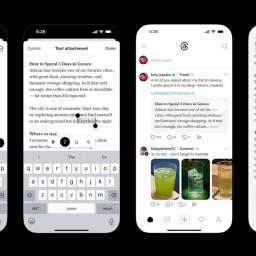 |
on (#6ZSRS)
That was fast. A week after a new feature for sharing long-form text was spotted in the Threads app, Meta is making the experiment official. Threads users will now be able to append text snippets of up to 10,000 characters to their posts in a feature Meta says is meant to support journalists and creators on the platform.As Engadget detailed last week, the feature is fairly basic for now. Selecting "text attachment" from the post composer opens up a simple text editor that has some formatting options. Once published to Threads, text attachments open either in a full-screen view on mobile or in a dedicated window on threads.com. If the post contains a link, the text attachment will also show a preview of the linked post at the end of text.That's notable as Meta has been trying to make links shared on Threads more prominent in an effort to give creators a boost on the platform. So far, there have been mixed results. While data shows engagement with links has been growing in recent months, Threads is sending very little traffic to websites overall.In a blog post, the company says the feature was inspired by user behavior as people frequently share "screenshots of longer content from books, articles, newsletters, podcast transcripts." The company also suggests that the feature could be used by authors and journalists who wish to share previews of their published works.While the 10,000 character limit technically means that authors and journalists could publish substantial amounts of writing directly on Threads, text attachments lack many features you'd expect from publishing tools. There are limited text formatting options, for example, and you can't embed media or do much else to break up big chunks of text. (A Meta spokesperson says highlighting and other formatting abilities are in the works.)Text attachments also aren't compatible with sharing to the fediverse, so followers from other ActivityPub services won't be able to see them even if you've opted in to fediverse sharing. But many users will likely still find the feature preferable to sharing lengthy multi-part Threads, which can be hard to follow and don't always all appear in a single view in the app or website.Meta says the feature is still in its early days and that it plans to add more functionality to text attachments in the future, along with more creator-focused updates.
|
 |
by Kris Holt on (#6ZSRT)
Tesla has made its iOS Robotaxi app available for all iPhone users to download as it expands service beyond a group of early access users for the first time. Beyond the current lack of an Android app (Tesla says one is on the way), there are a couple of things to bear in mind here. The company's proper robotaxis are currently only available in Austin, Texas. There's also a waitlist, so you won't be able to book a ride immediately.That said, it might not take folks on the waitlist too long to gain access to the service. Business Insider was able to start using it after about three hours.
|
 |
by Matt Tate on (#6ZSRV)
We're now several months into a brand new Nintendo generation, and waiting impatiently for important information such as the release date for Metroid Prime 4 and the whereabouts of the next 3D Mario game. But in the meantime, the company has been gradually updating its various retro console emulators on Nintendo Switch Online, with the latest being the Game Boy Advance.As spotted by Nintendo Everything, the 3.0.0 update to the GBA app adds button remapping, which is already possible with the N64 and SNES emulators. Accessible from the menu while playing a game, this allows you to mess around with controls if you're not happy with the default option, which admittedly does feel like something that should have been there from the beginning, but hey.Nintendo Everything adds that GBA games in the Nintendo Switch Online library are also now playable in 1080p in handheld mode on the Switch 2, which is hard to verify as there's no option to toggle video quality. Presumably any game booted on the newer hardware now just defaults to the higher resolution, where before they'd have been stretched from the original Switch's 720p maximum output. Of course, if the idea of playing a game from the early 2000s with pin-sharp clarity on a huge display appalls you, there is still the option of enabling a bordered small screen, as well as the classic feel" filter, which adds analog-y scanlines.Perhaps the most enjoyable addition of all, though, is the hidden original GBA startup screen, which you can activate by wiggling the analogue stick when booting the app. I tested this, and it is (obviously) delightful. Nintendo added a similar Easter egg to its GameCube app earlier this year.Unfortunately, the updated GBA emulator doesn't include any new game drops. The most recent title to join the service was Fire Emblem: The Sacred Stones back in April, which means the arduous wait for Nintendo to give us Mario Golf: Advance Tour continues. For me at least. Sigh.This article originally appeared on Engadget at https://www.engadget.com/gaming/the-switch-2s-latest-update-improves-the-consoles-gba-emulator-164340851.html?src=rss
|
 |
by Lawrence Bonk on (#6ZSN6)
The video-generation model Veo 3 has come to Google Photos, bringing even more AI tomfoolery to the platform. This allows users to do all sorts of wacky things. First and foremost, the pre-existing photo to video feature has been significantly improved. Google says that it can now be used to turn "still images into even higher-quality clips."There's also a tool called Remix that transforms photos into various styles, like anime drawings, comic book illustrations, 3D animations and more. This is a popular use case for image generators. You've probably seen those Studio Ghibli-inspired images across the internet.GoogleVeo 3 brings a new Collage tool that makes it easy to pick multiple photos and select a layout. There's even a simple image editor here that can be accessed directly from the collage maker.The Highlight tool creates visual montages based on search prompts, complete with music. There's also something called Cinematic Photos, which creates 3D renderings of pre-existing photos. Many of these tools can be combined to create unique images and videos.Google Photos with Veo 3 integration is available to US customers right now, and these tools can all be accessed in the new Create tab. Users only get a limited number of image generations each day, with more generations available for Google AI Pro and Ultra subscribers.This is just the latest platform that Google is sloppin' up with Veo 3. The company recently brought it to YouTube.This article originally appeared on Engadget at https://www.engadget.com/ai/google-photos-gets-veo-3-integration-bringing-in-even-more-ai-tools-160042831.html?src=rss
|
 |
by Andre Revilla on (#6ZSN7)
Adobe is bringing Premiere to iPhone for free, putting its powerful video editor in the hands of content creators on iOS. The app will offer easy exporting to TikTok, YouTube Shorts or Instagram with a single tap.Users of the desktop application will be familiar with the multi-track timeline and the app's core functionalities. Content creators will be able to splice video footage, fine-tune down to individual frames and add unlimited video, text or audio layers including voiceovers. Premiere will be able to handle 4K HDR footage and will include Adobe Lightroom color presets to help add a polished look to your footage. The app can resize the final output for posting on any platform.Adobe says all these traditional features will be available for free with no ads, and videos will be exported without watermarks. This is somewhat unusual for a company that has all but perfected the monthly subscription model for its suite of tools that used to cost hundreds of dollars for a permanent license. The zero cost is likely driven by competition from other free video editing apps like CapCut, which shares a parent company with TikTok. Instagram also rolled out a free video editor this year.For an AI-powered upgrade, users can buy generative AI credits to create sound effects, apply speech enhancement, or access AI assets generated through Adobe Firefly. Extra cloud storage will also be available for purchase through the app, which may explain why the App Store lists in-app purchases of $7.99 per month or $69.99 per year.The Adobe Premiere: Video Editor app is available to pre-save on the App Store with an expected release date of September 30. Adobe says that Premiere for Android is also under development.This article originally appeared on Engadget at https://www.engadget.com/mobile/adobe-premiere-is-coming-to-ios-later-this-month-155019427.html?src=rss
|
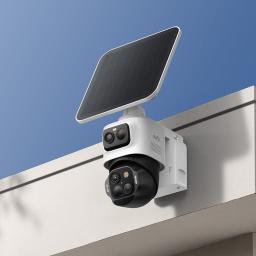 |
by Matt Tate on (#6ZSN8)
Eufy just introduced its latest outdoor security camera at IFA in Germany. The EufyCam S4 monitors your home using a fixed 4K wide-angle camera and a pair of 2K sensors that activate when a possible intruder is spotted and track them. Capable of auto-framing its subject, the main camera can pan, tilt and zoom in on a person as far as 164 feet away. It can also intelligently zoom out to ensure groups are kept in view.The EufyCam S4's stationary bullet camera has a 130-degree field of view, while the pan, tilt and zoom camera provides 360-degree tracking. With the three lenses working in unison, it's going to be pretty difficult for anyone to evade their gaze. The camera also has a dual motion detection system, combining radar and passive infrared (PIR) tech to distinguish between moving humans and vehicles. This way you should get fewer false alarms from the Eufy app.If the camera detects an intruder, red and blue warning lights are activated and a siren will trigger to warn them off. The camera can also be paired with Eufy's HomeBase S380 (sold separately), a smart security hub that uses the company's BionicMind AI tech for what it says is 99.9 percent accurate facial recognition. It also increases local storage to a sizable 16TB.The EufyCam S4 ships with a built-in 5.5 watt panel that can fully charge the camera with an hour of direct sunlight. The panel is detachable, so can easily be moved to an area where it'll drink up more rays, and you also get a rechargeable battery included so you're not exclusively relying on the sun.On its own, the EufyCamS4 costs $300 and will be available later this year. Bundles of multiple cameras and a HomeBase S380 will also be available.This article originally appeared on Engadget at https://www.engadget.com/home/smart-home/eufys-latest-security-camera-has-three-lenses-and-a-detachable-solar-panel-150014067.html?src=rss
|
 |
by Kris Holt on (#6ZSN9)
The Browser Company - the maker of the Arc and AI-centric Dia browsers - is set to have a new owner. Atlassian is buying it for around $610 million in an all-cash deal, which it expects to close in the second quarter of its fiscal year 2026 (i.e. by the end of the 2025 calendar year).According to The Browser Company, it will continue to operate independently as it builds Dia. A private beta for the browser started in June. Arc (a well-regarded browser on which the company has ended active development) and Arc Search will stick around, and a long-term plan for those will be revealed in the near future.Co-founders Josh Miller and Hursh Agrawal are staying on as CEO and CTO, respectively. Miller wrote in a blog post that they are looking to accelerate their ambitions by teaming up with Atlassian. "We chose Atlassian because their strengths complement our gaps," Miller wrote. "And most importantly, like us, they believe the browser is becoming the new operating system." The Browser Company plans to bring Dia to "to every platform faster than we could have previously imagined" in the coming months.Miller said the company had three conditions for any acquisition: to ensure it remained independent, that all of its team members still had a job and that its "vision for Dia remains at the center." He added that "a large part of why we chose Atlassian is values. Now more than ever. Not the kind you hang on a wall, but the ones you see in the work itself."Atlassian is the owner of productivity and enterprise services such as project management apps Jira and Trello (which has been buggy for me for over a year, for what it's worth). Last month, it reportedly laid off around 150 workers, many of whom were said to be in the customer service department, and was said to be planning to use AI to take over some of those former employees' tasks."Our vision is to make Dia the AI browser for work," Atlassian CEO Mike Cannon-Brookes said in a video announcing the acquisition. The team is designing Dia so it's "optimized for the SaaS [software as a service] apps where you spend your day; packed with AI skills and your personal work memory to unleash your potential; and built with trust and security in mind, so you can bring it to the office. An AI browser for your system of work."This article originally appeared on Engadget at https://www.engadget.com/big-tech/atlassian-is-buying-arc-maker-the-browser-company-for-610-million-145236236.html?src=rss
|
 |
by Lawrence Bonk on (#6ZSNA)
Hollow Knight: Silksong is officially available for purchase, after six long years of waiting. The anticipation is at a fever pitch. Fans have swarmed to Steam to purchase the game and, well, it looks like they overloaded the system and shut it down. The same thing seems to be happening to the Nintendo eShop and the Xbox Store.Multiple social media users and data from services like DownDetector are noting that the service is down for many people, with a massive spike in reports pretty much the moment Silksong became available. This could be a coincidence but it's probably not. Silksong is one of the hottest releases in recent memory.In any event, we've reached out to Steam and will update this post when we hear back or when the platform has returned. Congrats to those who already got their hands on the game.This is a developing story.This article originally appeared on Engadget at https://www.engadget.com/gaming/hollow-knight-silksong-fans-have-brought-down-steam-142116085.html?src=rss
|
 |
by Will Shanklin on (#6ZSHD)
TCL is showcasing a new phone at IFA 2025. A late entrant to the modern mobile market, the company tries to differentiate its devices with NXTPAPER eye-comfort screen tech. The new NXTPAPER 60 Ultra is TCL's first phone to feature the latest version of that technology, which it first introduced in a tablet at CES 2025.The idea behind NXTPAPER is to strike a balance between e-paper and OLED screens, alleviating eye strain without sacrificing color range or refresh rates. Its hardware-level features include blue light filtering, a matte anti-glare layer and flicker-free brightness control. One of its neatest aspects is Ink Mode, which can switch into an E Ink-like presentation with the press of a dedicated button. TCL says the 2025 version of the display tech (NXTPAPER 4.0) brings sharper detail, more accurate color and AI-driven eye comfort modes.TCLLooking beyond the eye-comfort features, the NXTPAPER 60 Ultra is a mid-range Android phone. It has a spacious 7.2-inch display with a 120Hz refresh rate with 1080p resolution. It's powered by a MediaTek Dimensity 7400 processor and 12GB of RAM. (An additional 12GB is available via virtual RAM.) The phone has a three-camera setup, including a 50MP periscope telephoto sensor. (That camera provides 3x optical zoom and 6x "lossless" zoom via digital trickery.) The phone has a 5,200 mAh battery.At least for now, the NXTPAPER 60 Ultra is only launching in Europe, Latin America and Asian markets. It will be available there later this month, priced at 499 for 256GB storage and 549 for 512GB.This article originally appeared on Engadget at https://www.engadget.com/mobile/smartphones/tcls-new-smartphone-uses-the-latest-version-of-its-eye-comfort-screen-tech-133041739.html?src=rss
|
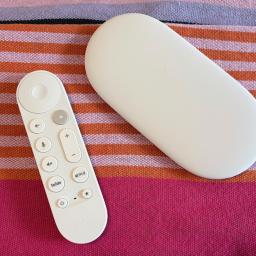 |
by Lawrence Bonk on (#6ZR2G)
A good streaming device can revamp an older TV for much less than it would cost to replace the set all together. One of our favorites in the Google TV Streamer 4K, and you can pick it up for 20 percent off right now. It's on sale for $80, which is close to a record-low price and a few dollars less than it was during Prime Day this summer. The TV Streamer 4K topped our list of the best streaming devices. It's a smartly-designed product that just works. We enjoyed the clean interface and the fantastic remote that ships with the device. The processor is speedy and this thing can stream content in 4K at 60FPS. It integrates with HDR, HDR10, HDR10+ and Dolby Vision. On the audio side of things, it supports formats like Dolby Digital and Dolby Atmos. It can even handle spatial audio, so long as you're wearing the Pixel Buds Pro earbuds. The interface includes a smart home control hub, which we praised in our official review. This lets users easily control smart lights and thermostats, among other gadgets. The TV Streamer 4K also offers voice control, which we found to be useful. There are only two minor knocks with this one. The original asking price is on the higher end, but this sale alleviates that concern. The unit also includes some fairly useless AI integration, but it's 2025 so what else is new? Follow @EngadgetDeals on X for the latest tech deals and buying advice.This article originally appeared on Engadget at https://www.engadget.com/deals/the-google-tv-streamer-4k-is-20-percent-off-right-now-183511702.html?src=rss
|
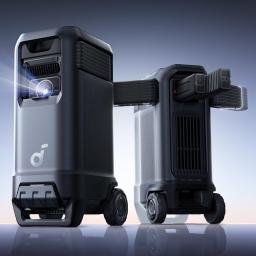 |
by Steve Dent on (#6ZSHE)
Anker took it's excellent Nebula X1 projector and said, "what if that but louder?" The result is the Soundcore Nebula X1 Pro that marries Anker's 4K, 3,500 lumen Google TV projector with a 160W Soundcore speaker, offering what should be an incredible outdoor entertainment machine.Marrying these products wasn't just a matter of jamming them into the same box. The subwoofer was set up to float inside the assembly on a spring-type system to avoid vibrating the laser-powered 4K video. And to get some semblance of soundstage, the 80W soundbar speakers fold out to the left and right of the projector, with two wireless satellites completing the 7.1.4 surround effect. It even supports Dolby Atmos, which the projector on its own doesn't do, while also offering IP43 protection from light rain and dust, another feature absent on the Nebula X1.AnkerOtherwise, it's the same excellent triple-laser, glass lens projector I tested last month that offers outstanding image quality, a simple automatic setup thanks to the motorized lens and surprising portability. Considering it's mean for outdoor use, it puts a lot of dedicated indoor projectors to shame in terms of brightness and color accuracy. When not beaming movies, the system can also be used in audio-only Bluetooth speaker mode.The Soundcore Nebula X1 Pro will launch on September 23rd on Kickstarter (at between $4,000 to $5,000), just as the Nebula X1 projector did. It will then come to retail a bit later, around March 2026. The company is also offering the opportunity to leave a $100 deposit and get $500 off.This article originally appeared on Engadget at https://www.engadget.com/home/home-theater/ankers-soundcore-nebula-x1-pro-is-the-ultimate-party-projector-130255687.html?src=rss
|
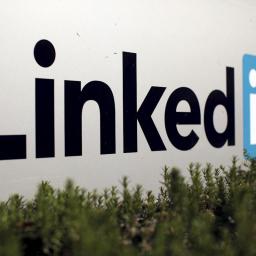 |
by Ian Carlos Campbell on (#6ZSHF)
LinkedIn will now require some users to verify their identity before they change job titles in an attempt to cut down on scams on the platform. The new identity verification rules will specifically apply to executives and recruiters who interact with job seekers or represent a company in one form or another.As part of these changes, LinkedIn says users who add or update their title to anything recruiter-related (recruiter, talent acquisition, etc.) will have to verify their workplace on their profiles. The same identity verification rules will apply to executives, as well, which LinkedIn says covers titles like "Executive Director, Managing Director, and Vice President." Verifying your workplace requires you to provide an official email address that uses your company's domain name. The new requirement only applies to people changing roles, existing recruiters and executives won't have to verify.LinkedInLinkedIn has offered similar verification tools to select companies upon request, but now the platform says it'll open up the option to every company with a LinkedIn page via a new "Premium Company Page subscription." A verified company should be easier to trust when paired with verified employees.While LinkedIn is best known as a home for thought leadership and a necessary evil in job hunts, it's also the site of a large amount of fraud. Scammers impersonate company employees to collect data from fake job postings or conduct elaborate investment schemes, as CNBC reported in 2022. LinkedIn has automated systems for weeding out fake accounts, and rolled out an earlier wave of anti-scam features focused on job postings in 2023, but this new system should offer even more security.This article originally appeared on Engadget at https://www.engadget.com/social-media/linkedin-will-require-recruiters-and-executives-to-verify-their-identity-to-cut-down-on-scams-130040435.html?src=rss
|
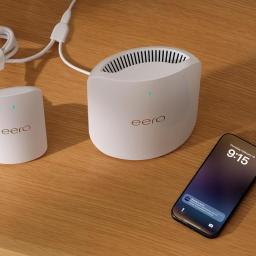 |
by Mariella Moon on (#6ZSEV)
Amazon has introduced a new eero product at IFA 2025, which can provide you with connectivity in case your home internet goes out. The new product called eero Signal connects to any USB-C-powered eero device on a network that supports Wi-Fi 6 and up. It's meant to be a cellular backup, available two versions: A 4G LTE one that will cost you $100 and a 5G one that will set you back $200. Signal can detect outages and automatically connect you to a cellular network with its multi-carrier eSIM that's already included with the price of the device. It also switches back to your home internet once it detects that it's back online. To note, Signal isn't meant for standalone use. It's only meant as a backup that requires an existing primary internet connection and will only work in a single location. The device was designed to keep you connected when you would've had no home internet otherwise. You will need an annual eero Plus subscription to be able to enjoy its benefits, though it's coming to eero Business as well. An annual eero Plus plan will set you back $99 a year for all its perks, including access to a VPN, an antivirus, a password manager and 10GB of backup data. If you live in a place that experiences frequent outages, you can get the new annual eero Plus 100 plan that will come with 100GB of backup data for $200 a year. This article originally appeared on Engadget at https://www.engadget.com/computing/amazon-launches-cellular-dongle-to-provide-backup-connectivity-for-eero-routers-123028654.html?src=rss
|
 |
by Mariella Moon on (#6ZSEW)
Google must pay $425 million to the plaintiffs of a class action lawsuit that accused the company of collecting users' data even after they've turned off a tracking feature, a federal jury has decided. The lead plaintiff sued Google back in July 2020, arguing that the company still harvested data even though it tells users they can disable tracking under Web & App Activity through its connection with other apps, such as Uber and Instagram. US District Judge Richard Seeborg then certified the lawsuit as class action, involving 98 million Google users and 174 million devices.The plaintiffs' lawyers asked for $31 billion in damages, but the jury only found Google liable on two of the three privacy violation claims. Google didn't violate the California Comprehensive Computer Data Access and Fraud Act and didn't act out of malice, the jury found. As a result, the jury concluded that the plaintiffs aren't entitled to any punitive damages.In a statement, Google spokesperson Jose Castaneda said that the decision "misunderstands how [their] products work." He added that the company's privacy tools give users control over their data and insisted that Google honors people's choice to turn off personalization. Castaneda said that Google plans to appeal.The company faced several similar privacy lawsuits in the past. Another 2020 lawsuit accused Google of tracking users in Incognito mode, and the company agreed to settle the $5 billion lawsuit in 2023. A year later, it admitted that it can indeed collect information in Incognito and promised to destroy billions of data collected from Incognito tracking to settle the complaint.This article originally appeared on Engadget at https://www.engadget.com/big-tech/google-ordered-to-pay-425-million-in-app-data-collection-lawsuit-120048799.html?src=rss
|
 |
on (#6ZSEX)
Since the start of last summer, DuckDuckGo has offered a handful of AI chatbots from OpenAI, Anthropic and others directly through its browser. And while it's mostly low-cost models like GPT-4o mini and Claude 3.5 Haiku on offer, the feature, Duck.ai, allows you to use those tools without sacrificing your privacy. As a service, that appears to have resonated with DuckDuckGo users, and now the company is reorienting its Privacy Pro subscription around access to more advanced models from those providers.The good news? The price of the service - either $10 per month or $100 billed annually - remains unchanged, and you still get all the previous perks included in the package. What is changing is the name. It's now simply known as the DuckDuckGo subscription, and, in addition to offering access to the company's own VPN, as well as its personal information removal and identity protection services, it allows you to use some of the latest models from OpenAI, Anthropic and Meta. The full list features GPT-4o, GPT-5, Sonnet 4.0 and Llama 4 Maverick. As before, any conversations you have with those chatbots through DuckDuckGo are anonymized and your data won't be used for training future systems."Today, we're expanding Duck.ai by giving DuckDuckGo subscribers access to more advanced AI models, covered by the same strong protections," said DuckDuckGo. "The base version of Duck.ai is not changing; it's still free to use, with no account necessary. We're just adding more models for subscribers."If you don't want to use the new AI perks, you don't have to; DuckDuckGo allows users to hide all the AI buttons found in its browser's search, desktop and mobile settings. That said, the company notes it's exploring the option of offering higher subscription tiers with access to even more advanced AI models in the future.This article originally appeared on Engadget at https://www.engadget.com/duckduckgos-subscription-now-offers-some-of-the-latest-chatbots-from-openai-and-anthropic-120000845.html?src=rss
|
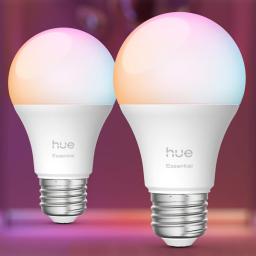 |
by Steve Dent on (#6ZSEY)
Hue just did its biggest product launch ever as part of IFA 2025 and a key product is the new entry-level Essential smart bulb lineup. Though still not as cheap as some products you can find on Amazon, it's designed to take on budget rivals like Govee and Aqara with bulbs starting under $20.The new range includes A19 bulbs, GU10 spots and strip lights with and without color options. Effectively, you're not losing a lot compared to the regular color/white bulbs. They still run on the same platform and offer Bluetooth out of the box along with extra features enabled when using a bridge or Matter-over-Thread.To highlight the differences, Hue released a feature comparison sheet. You can't dim the Essential bulbs as much, they offer a reduced range of whites (2200 to 6500K compared to 1000 to 20000K) and color quality is less accurate. The latter is arguably the most important feature for folks who use smart bulbs to sync with their TVs or require precise matching between bulbs.HueYou'll be able to buy the Hue Essential bulbs starting this month, with the new A19 bulbs priced at $25 individually or $60 in a four-pack. The Essential strip light arrives in December for $60 in a 5 meter length (16 feet) or $100 for 10 meters (33 feet). You can also grab the A19 bulb in a starter kit in the US starting at $80 for the Essential E27 2 pieces and Hue Bridge V2, up to $100 for the Essential E27 4 pieces and Hue Bridge V2.Another primary piece of Hue's smart lighting puzzle is the Hue Bridge Pro. It has a more serious black look compared to the white models of the past to signify the extra power. That includes five times the processing performance and 15 times the memory of the Hue Bridge V2 that came out 10 years ago.HueAlong with the extra power, the Huge Bridge Pro debuts a new feature called Hue Motion Aware. That transforms Hue Bulbs (including 95 percent of existing models) into motion sensors able to detect movement and trigger actions or security alerts.Hue says you can easily upgrade a current Hue Bridge "with just a few clicks," and Signify will release support for combining multiple Bridges into a single Bridge Pro by year's end. The Bridge pro arrives in North America in September 2025 for $90.Hue OmniGlow strip lightingJuanCruzDuranPhotographer for HueHue also refreshed its strip lighting with several new products including the flagship OmniGlow (starting at $140 for a 3 meter length and arriving in November), the first Hue strip with no visible hotspots via CSP tech to accent your decor with a seamless glow. It also introduced the Flux lineup with indoor, outdoor, ultra-bright and neon options (in sizes up to 10m) starting at $70 for 3 meters, for applications ranging from indoor accents to outdoor facades. Also new are the Festavia string lights that can be used for holiday decor or year round in a permanent model for rooflines, patios and balconies. Those start at $160 for 7m lengths or $120 for 9 meters for the permanent model with availability in September.Signify also introduced a new A19 bulb that can replicate the entire spectrum of daylight while offering 40 percent great efficiency compared to its predecessor. Finally, the company announced a Sonos partnership that will allow you to operates Philips Hue lights using voice controls, and eventually "integrate light and sound in new intuitive ways."This article originally appeared on Engadget at https://www.engadget.com/home/smart-home/hue-takes-on-cheaper-rivals-with-the-entry-level-essential-smart-bulb-lineup-110415932.html?src=rss
|
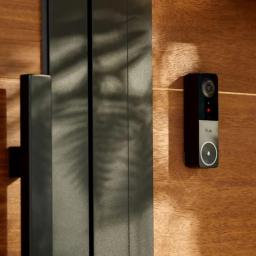 |
by Steve Dent on (#6ZSC5)
Hue is best known for its smart lights, but recently the company ventured into home security with its Secure lineup of cameras. Now, parent Signify is releasing its first video doorbell, the Hue Secure, with several unique features it hopes will make it stand out against formidable competition from Nest and Amazon's Ring.To start with, the Hue doorbell comes with a 2K fisheye camera, more resolution than Nest and some of Ring's doorbell products, potentially offering more detailed video. Hue is also offering a 24-hour video history for free, letting you avoid paying for a subscription if you only want to keep a day's worth of clips. In addition, the camera can work with Google Home and Samsung SmartThings, along with Hue's own app. It won't be compatible with Apple Home at launch, but will be updated to work with it later. Signify will also add Matter support sometime this fall.HueAlong with 2.4GHz and 5GHz Wi-Fi compatibility, the Hue Secure video doorbell come with a Zigbee radio. That lets it pair with Hue lights, so you can set it up to automatically turn on other Hue lights (inside your foyer or outside the door, for instance) when someone approaches the front door. However, if you want a chime to compliment the Hue Secure by providing sound alerts when the doorbell rings, you'll need to buy the $60 Hue Smart Chime that's sold separately - as the new doorbell doesn't work with any third-party chimes for now.Hue's Security video doorbell arrives in October in North America, Europe and the UK for $170 (140). Signify will also release a new 2K wired camera in Europe that's an update to the original Hue security cameras. That model will cost 180 or 200 with a stand, with no word yet on US availability.This article originally appeared on Engadget at https://www.engadget.com/home/smart-home/hues-secure-video-doorbell-can-turn-on-hue-lights-when-someone-comes-to-the-door-100017068.html?src=rss
|
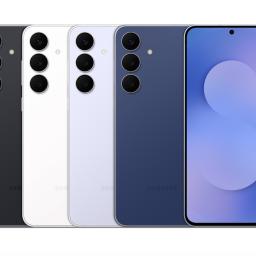 |
by Lawrence Bonk on (#6ZSC6)
Samsung just launched the Galaxy S25 FE smartphone at IFA. It's available right now, starting at $650. The handset is available in four colorways. This is a midrange member of the Galaxy S25 family, after the company released the S25, S25 Plus and S25 Ultra back in January and the ultra-thin S25 Edge in May. The base-level S25 starts at $800, so this is a slightly cheaper way to get in on all of that Galaxy action. This phone actually ships with the company's One UI 8 operating system. The other S25 models shipped with One UI 7, but have since begun receiving software updates to bring them up to speed. This introduces a refreshed user interface with new icons and better animations, more AI integration and improved split-screen performance. It features an Exynos 2400 CPU, which should get the job done but won't be quite as snappy as the Qualcomm Snapdragon 8 Elite that ships with the rest of the lineup. There's a 6.7-inch AMOLED screen with up to 1,900 nits of peak brightness. The camera system is decent, with a 50MP main camera, a 12MP ultra-wide lens and an 8MP telephoto lens. There's also a 12MP front-facing camera. Despite being a bit underpowered when compared to the rest of the lineup, the S25 FE still accommodates all of those fancy Galaxy AI bells and whistles. This includes the company's Generative Edit photo software, an on-device assistant and more. So this is a relatively affordable entryway into that world. This article originally appeared on Engadget at https://www.engadget.com/mobile/smartphones/samsung-launches-the-galaxy-s25-fe-at-ifa-2025-093026581.html?src=rss
|
 |
by Cherlynn Low on (#6ZSC7)
Someone recently asked me: Who even cares about Android tablets anymore? If that's you, you're probably feeling the same indifference towards premium Android tablets. Even Google has conceded it won't be making new tablets and seems to have already forgotten about the Pixel Tablet. But that's not stopping Samsung from releasing the 11th-generation Galaxy Tab S11 series, comprising the 11-inch standard model and 14.6-inch Ultra. The latter is the more interesting of the pair, as it's not only what Samsung says is its thinnest tablet ever, but also offers new Dex multitasking features and, of course, AI tools. Plus, in case you forgot, the company's hallmark S Pen stylus still exists, and has received yet another redesign alongside the launch of the series. These days, my stylus use is limited to the ones for e-paper writing tablets like the reMarkable Paper Pro and the Kindle Scribe, but I remain a huge fan of the S Pen. I've loved Samsung's stylus since my time as an Omnia II owner, back when it was like a mini retractable pointer that extended like old car antennas. The version accompanying the Tab S11 Ultra has a hexagonal shape to its grip that makes it more closely resemble a No. 2 pencil, and its nib has also been tweaked to be more conical. From my brief time with it at a hands-on session, the latest S Pen didn't feel remarkable. It's certainly a lot lighter than the reMarkable Paper Pro's Marker Plus. But despite its similarity to a No. 2 pencil, Samsung's new stylus didn't feel better to hold or write with than the Kindle Scribe's pen, which is a simple cylindrical piece. I actually like how smooth the latter's edges are, and both seemed to deliver similarly fluid and responsive writing. I didn't feel much resistance as I dragged the S Pen's nib across the Tab S11 Ultra's screen to scrawl out Hello Engadget." Cherlynn Low for Engadget Unlike some previous S Pens that had Bluetooth-powered special features like remote camera control, this version has no additional connectivity. It draws power from the tablet's screen like other EMR (electromagnetic resonance) tablets and won't need to be charged. Samsung did make it attach magnetically to the S11 Ultra, which can help prevent you misplacing it in a cafe, for example. But from previous experience, I can say that the magnets aren't strong enough to keep the S Pen on the tablet if you toss it in a purse or bag. You'll need a case with a dedicated holder to truly secure the stylus. Speaking of, Samsung has made some new covers and keyboards for the Tab S11 Ultra, since its pogo pins have been moved from the bottom edge to its rear. This means none of your old or existing Samsung keyboard cases will be compatible, and you'll have to buy the new version if you want to turn the S11 Ultra into a competent 2-in-1. Samsung improved the cases for its latest tablet, though, and it seems the repositioned pogo pins have allowed the company to make its origami covers a single piece instead of a two-parter. The new Pro keyboard case won't be available at launch, so you'll have to wait to get it and perhaps rely on a Bluetooth accessory in the meantime. Or you can get the Slim Keyboard, which doesn't have a trackpad. Once you get a working keyboard connected, you'll likely have a nice time getting work done on the S11 Ultra. That's thanks in large part to the improved Dex mode, Samsung's multitasking software for Android devices. The new tablet ships with One UI 8, which gets new multitasking features like Extended Mode and support for up to four dedicated customizable workspaces. The former basically lets you wirelessly extend your display to other screens, like another tablet or even a laptop or monitor, to simulate a dual-monitor setup. I didn't get to see this for myself yet, so I can't speak to the latency and ease of use, but the idea is nice in theory, and is something iPads can't do yet. You might not even need extra screens, though, since the Tab S11 Ultra's display is a roomy 14.6 inches, which Samsung says is its largest yet. It offers the vibrancy and brightness that's typical of the company's AMOLEDs, meaning colors are richly saturated and make for an enjoyable multimedia experience. Like recent models, the S11 Ultra's panel refreshes at up to 120Hz for smoother scrolling and animations, and has a fairly sharp resolution of 2,960 x 1,848. If you really care about numbers, then know that the Tab S11 Ultra gets up to 1,600 nits of brightness, as well. All this is powered by a 3nm MediaTek Dimensity 9400+ processor, which the company said is a first for its tablets and brings 20 percent improved CPU and GPU performance over the previous generation. The neural processing unit (NPU) also sees a jump of 30 percent, according to Samsung. That means AI tools like Writing Assist and Drawing Assist should be faster and smoother. Cherlynn Low for Engadget In addition to those tools, which help you adjust the tone of your messages or turn your rough sketches into full-fledged art, the Tab S11 Ultra will also support Google's Gemini Live so you can have more natural conversations with the assistant. Samsung is also rolling out a Galaxy AI overlay for its Notes and browser apps, allowing you to drag around a moveable panel on top of those windows for easier reference. Despite how I started this article, I've actually long been a fan of Samsung's Galaxy Tab S line. I love how thin and sturdy they are - they just feel like sharp gadgets to wield. And at just 5.1mm (0.2 inches) thin and weighing just 1.53 pounds (692 grams), the Tab S11 Ultra is impressively svelte. Holding it up with just one hand while I aimed my camera at it felt effortless, and despite measuring 8.2 x 12.8 inches, the tablet was relatively easy to maneuver. By the way, the S11 Ultra's bezels measure 5.2mm, meaning even the barely-there borders are thicker than the device. And in case you needed a comparison, the 13-inch iPad Pro from 2024 was also 5.1mm thin. The Tab S11 Ultra has a bigger screen while keeping that slim profile. It also is rated IP68 so it can withstand about the same amount of dust and water ingress as the average smartphone today. While I wasn't able to test the battery life of the Tab S11 and Tab S11 Ultra at the hands-on event, I think their respective 8,400mAh and 11,600mAh cells should provide ample runtime to get work done on the go. Samsung says they'll both last about 13 hours on a charge. I'll take this opportunity to point out that the Tab S11 is a much less premium device, with noticeably thicker bezels around its 10.9-inch screen. It supports Wi-Fi 6E, while the Ultra gets up to Wi-Fi 7, and it has a headphone jack if you still want one. The Ultra, meanwhile, does not have a 3.5mm audio socket. Cherlynn Low for Engadget In most other respects, the Tab S11 and its Ultra sibling share similar specs. Both have 13-megapixel rear cameras and 12MP front sensors, though the Ultra has an additional 8MP ultrawide setup. They support the redesigned S Pen, have in-screen fingerprint sensors, use the same processor, start at the same 12GB of RAM and go up to 2TB of storage, all while running Android 16. I'm truly intrigued and tempted by the Tab S11 Ultra's promise of portable productivity in a handsome package, but I simply don't use tablets in my life. My personal laptop is a Samsung Galaxy Book, and that feels like a suitable medium-screen to join my small screen (phone), big screen (TV) and tiny screen (watch). I don't need to throw a smedium screen into the mix. I already have a Kindle and a reMarkable Paper Pro that take the place of books and notebooks, too. That said, for the non-Apple people who use tablets as laptop replacements, artists who want to sketch in color or simply anyone who just likes a 15-inch thin and light touchscreen for whatever reason, the Galaxy Tab S11 Ultra should be a worthy option. It's just going to be quite the hefty investment at $1,200 to start. That's costlier than most laptops, and doesn't include accessories like keyboard cases or mice yet. The base Tab S11 goes for $800, which is also more expensive than the plethora of midrange laptops on the market, so you'll be paying a premium for portability. This article originally appeared on Engadget at https://www.engadget.com/mobile/tablets/samsung-galaxy-tab-s11-ultra-hands-on-really-thin-redesigned-s-pen-and-remember-dex-093015036.html?src=rss
|
 |
by Lawrence Bonk on (#6ZS9V)
Eufy just introduced a couple of new devices at the IFA conference in Germany, including something called the MarsWalker. This little doodad picks up robot vacuums and carries them up and down stairs. That's pretty neat, considering stairs are the bane of any robovac's existence.The company says the MarsWalker automatically recognizes common stair types, including straight, L-shaped and U-shaped. It transports the vacuum between floors and drops it off at the base station when needed. Eufy boasts that the device allows for "truly hands-free, whole-home cleaning while avoiding the cost of buying multiple devices."It uses four control arms that "dynamically adapt to stair structures," along with a track-drive system that "grips each step securely." The company notes that it has been designed to prevent slips.There are a couple of caveats here. First of all, we don't have the price yet. If this ends up being around the price of an actual robot vacuum, it might be better just to get two for a multi-story home. Also, it only works with a few Eufy models and no third-party devices. Still, it's cool to see robot vacuums finally adapting to stairs. It's been a slow road to get here. The MarsWalker will be released in the first half of 2026.EufyThe company also announced a new robovac at IFA which fully integrates with the MarsWalker. The Omni S2 includes an aromatherapy system, which is fairly novel, and adaptive wheels to clear thresholds like thick rugs. It'll be available in January, with a cost of $1,600.This article originally appeared on Engadget at https://www.engadget.com/home/smart-home/eufys-marswalker-allows-its-robot-vacuums-to-climb-stairs-083020319.html?src=rss
|
 |
by Anna Washenko on (#6ZS47)
Apple continues to seek a foothold in the artificial intelligence race, and its next effort could bring the company into web search. Mark Gurman at Bloomberg reports that Apple is building a search platform that it may incorporate into its AI-driven overhaul of Siri. Sources said the tool, internally called World Knowledge Answers, could also be added to the Safari web browser and the Spotlight smartphone search interface.Apple's efforts in AI have been under the microscope since the lackluster introduction of Apple Intelligence at WWDC 2024. Since then, the company appears to still be foundering, with its revitalized and AI-empowered Siri now not due to arrive until 2026. This proposed search tool would be part of that planned Siri re-launch next spring.Some core aspects of Siri are still up in the air. The company has reportedly trialed using Google's Gemini to power a version of the AI assistant, although it hasn't committed to using that approach. Considering an outside partnership for this critical feature is one path Apple could take to bolstering its AI offerings. CEO Tim Cook has also said the company is open to acquisitions to pursue its current roadmap. There were even rumors that the company had its eyes on snapping up Perplexity.Apple has historically avoided getting involved in search, but this development could reflect how more of its potential customers are turning to AI chatbots to access information online. And particularly if the company brings an AI option to Safari, Apple might be able to compete more directly to other tech majors that offer their own-branded chatbots, such as Google with Gemini or Microsoft with Copilot. It could also draw closer to parity with AI companies that are entering the browser game, such as Perplexity and OpenAI.This article originally appeared on Engadget at https://www.engadget.com/ai/apples-latest-ai-project-may-be-a-web-search-tool-230618495.html?src=rss
|
 |
by Ian Carlos Campbell on (#6ZS2H)
OpenAI has announced that it's making its Projects feature available to free users of ChatGPT. Projects let you organize chats with the company's AI assistant around a specific subject, and were previously one of several privileges only enjoyed by paid subscribers.While on some level Projects are glorified folders for ChatGPT conversations, the ability to set custom instructions for how the AI responds or limit what information and files it can reference, makes the feature a useful option for power users. As part of this rollout, OpenAI is also increasing the number of files that can be added to a project for ChatGPT to reference. Free users can upload five, Plus subscribers can upload 25 and Pro subscribers can upload 40. Whether you pay for ChatGPT or not, you'll also be able to customize the color and icon for your project, too.OpenAI has made a habit of slowly trickling down paid features to its free users over the last few years. Things like Deep Research and ChatGPT Voice started off as exclusives for the company's subscribers before becoming available to everyone. Offering a formerly premium feature with limits is itself a way to get free customers to become paid ones. OpenAI's decision to make the recently released GPT-5 model available to everyone at launch, but with harsher limits on how many times free users can use it follows a similar logic.Projects are available for free users on the web and in the ChatGPT app for Android. OpenAI says the iOS ChatGPT app will receive the feature "over the coming days."This article originally appeared on Engadget at https://www.engadget.com/ai/openai-rolls-out-chatgpt-projects-to-free-users-215027802.html?src=rss
|
 |
by Anna Washenko on (#6ZRZW)
Roblox announced that it aims to roll out age estimation technology to all of its users by the end of 2025. Users on the gaming and social network will have to confirm their age in order to access communication features within the platform under the new policy. Roblox initially rolled out an age verification option to teen accounts in July as part of an effort to keep users younger than 13 from accessing select chat features.In addition to confirming ages for individual accounts, Roblox also said it plans to adopt new systems that will limit communication between adults and minors unless they already know each other offline. Age verification can be completed by providing a selfie that Roblox and its partner will analyze or by submitting an accepted form of identification.Roblox has drawn criticism for what many claim are failures to adequately protect younger users from bad actors, including facing lawsuits. The platform started rolling out more stringent policies aimed at child safety last year. These rules kept some interactive features away from the under 13 age group, while other additions were aimed at giving parents tools to curate their children's experience.Age verification is becoming a go-to method to try and protect minors from accessing inappropriate content online. Utah was the first state to adopt a requirement to prove users' ages in order to access app stores, and other states like Mississippi are placing similar requirements on social media networks. There have been legal challenges, however. The tech sector has been arguing that their platforms should not be responsible for confirming ages, while digital privacy advocates have questioned whether sufficient protections have been enacted to keep users' personal information safe with these new laws.This article originally appeared on Engadget at https://www.engadget.com/gaming/roblox-will-require-age-verification-for-all-users-to-access-communication-features-203653330.html?src=rss
|
 |
by Ian Carlos Campbell on (#6ZRF8)
Acer maintains two different gaming product lines and it's updating both of them at IFA 2025. Among the new gear is a gigantic new 18-inch Predator laptop, an ultra high-refresh rate monitor and multiple entry-level Nitro laptops and monitors.The updated Predator Helios 18P AI is an even more powerful version of the Predator Helio 18 the company showed off at CES 2024, offering "desktop-level AI" in what's still technically a portable body. Inside, you can get up to an Intel Core Ultra 9 processor, a NVIDIA GeForce RTX 5090 laptop GPU and 6TB of SSD storage. For the display of the panel, you'll get a Mini LED 4K panel, which should work well for creative workflows and gaming. Acer also says the new Helios uses its "proprietary thermal solution" to keep cool, which is a combination of thin metal fans, "liquid metal thermal grease" and vector heat pipes.Acer has new gaming desktop PCs, the Predator Orion 7000 and Orion 5000, which can use GeForce RTX 5090 or 5080 GPUs, respectively. The more exciting announcement, though, is the new Predator monitor. The Predator X27U F8 Monitor is a 26.5-inch OLED, with a 2,560 x 1,440 resolution and a ridiculous 720Hz refresh rate if you're willing to run the monitor at 720p rather than 1440p. The X27U F8 monitor also supports AMD FreeSync Premium Pro to eliminate screen tearing and stuttering.AcerOn the Nitro side of the house, Acer has two new gaming laptops on offer. The Acer Nitro V 16 can be built with up to an Intel Core 9 processor and a NVIDIA GeForce RTX 5070 laptop GPU. With NVIDIA inside, the laptop supports NVIDIA DLSS 4 for improved graphics performance. The laptop also comes with a 2,560 x 1,600 display that has up to an 180Hz refresh rate for fluid motion during fast-paced games. The Acer Nitro V 16S, while similar, is more focused on portability. The laptop has up to an Intel Core 9 processor, but only a NVIDIA GeForce RTX 5070 laptop GPU, the same 180Hz display, in a metal body that's 19.9mm thin. That's not quite MacBook Air dimensions, but it's better than nothing.Acer is pairing those new laptops with a collection of new Nitro monitors. The largest option is the 39.7-inch curved Nitro XZ403CKR monitor, which uses a 5K panel, has built-in 5W speakers and supports AMD FreeSync Premium for fluid gameplay. If you like 5K but don't want a curved screen, there's the 27-inch Nitro XV270X, which includes two built-in 2W speakers. You can get similar speakers on the 27-inch Nitro XV273U W1 monitor, which has a 27-inch 1440p display that reaches 500 nits of peak brightness. Finally, there's also the Nitro XV275K V6, which features a 27-inch 4K display, AMD FreeSync Premium and dual HDMI 2.1 ports.Acer hasn't announced a final price or release for the Predator Helios 18P AI laptop, but did confirm it will be available in North America at launch. The Predator X27U F8 monitor, meanwhile, will go on sale in Q1 2026 for $1,300.For the Nitro laptops, Acer says the Nitro V 16 will be available in the US in October starting at $1,000, with the Acer Nitro V 16S arriving a month later in November for $1,100. For the Nitro monitors, all three will be available in Q1 2026. The Acer Nitro XV25K V6 starts at $700, the Acer Nitro XV273U W1 starts at $300, the Acer Nitro XV270X starts at $900 and the Acer Nitro XZ403CKR starts at $1,000.Update, September 3 2025, 3:34PM ET: Updated the article to clarify that the Predator X27U F8 Monitor only hits its 720Hz refresh rate when it's displaying content in 720p.This article originally appeared on Engadget at https://www.engadget.com/computing/laptops/acers-new-gaming-lineup-includes-an-18-inch-ai-laptop-and-a-720hz-monitor-090009032.html?src=rss
|
 |
by Kris Holt on (#6ZRZX)
A PlayStation State of Play showcase all about 007 First Light shed some light on how Hitman developer IO Interactive's James Bond game works. The stream also disclosed what was, until now, a top-secret nugget of intel: the release date. 007 First Light is coming to PlayStation 5, Xbox Series X/S, Nintendo Switch 2, Steam and Epic Games Store on March 27.The State of Play included a partial playthrough of the first mission, which sees Bond stealthily tailing a suspicious bellhop through a fancy hotel. Some time later, Bond breaks into a car to chase down a target, which leads into an explosive shootout. In a neat touch, Bond is granted a license to kill when enemies are about to shoot at him. One of my favorite bits from the gameplay deep dive showed Bond pushing an enemy off a ledge and using the baddie to break his own fall.Bond uses all the tricks of the trade, including distractions, gadgets and sweet talking NPCs. As with the Hitman series, you'll have plenty of options as to how to complete your objectives. Being a Bond project, of course there's plenty of product placement too. You can read more details about what to expect from the game in our preview.In addition, IO Interactive revealed the game's main cast during the State of Play. Patrick Gibson (The Tudors, Dexter: Original Sin) is playing 007. The cast also includes Priyanga Burford as M, Alastair Mackenzie as Q, Kiera Lester as Miss Moneypenny, Lennie James as John Greenway and Noemie Nakai as Miss Roth. What are the odds that at least one of those will turn out to be a double agent?Pre-orders are open now. If you do lock in a pre-order for the $70 base edition, you'll get a free upgrade to 007 First Light - Deluxe Edition, which includes 24 hours of early access, as well as exclusive outfits and skins for weapons and gadgets.This article originally appeared on Engadget at https://www.engadget.com/gaming/007-first-light-is-coming-to-ps5-xbox-series-xs-nintendo-switch-2-and-pc-on-march-27-191011686.html?src=rss
|
 |
by Mat Smith on (#6ZRX8)
IO Interactive seemingly wrapped up its assassination series Hitman in 2023, launching the anthology on practically every game platform. But it's not done with sneaking, subterfuge, and... sniper rifles. The game developer announced that it was making a new James Bond game, teasing an "unrefined" Bond in training - yes, it's another reimagined origin story.At a closed-door briefing at Gamescom, I watched the team play through some early parts of 007 First Light, with Bond part of a team of more seasoned spies hunting down a rogue double-o' agent. Ah, that sounds like a Bond plot.The gameplay was separated into three parts. First, the creative, exploratory sandbox part, as Bond tries to elbow his way into a bougie mansion - when he should be readying the escape car. Like Hitman, Bond can sneak around, triggering items to draw away guards or distract from his own actions. He scrambles up a building to get in through an open window, while vaguely flirting with staff and pretending he's meant to be there. The team explained that social interactions will form another part of how the rookie agent can interact with people and progress through areas and toward goals.Some features differentiate First Light from the aforementioned bald-headed assassination games. First of all, it's far less centered on all the killing (at least until the full-throttle action sections later), with the team attempting to reflect Bond adventures beyond bullets and grizzly ends.There's also an Omega-branded Q Watch that attempts to elegantly fold in HUD features like location markers, weaponry, and gadget selection. It'll also help analyze the environment for interactive parts and opportunities for Bond. Players will apparently have a degree of freedom to decide how they approach missions and areas, even if we only saw one approach during this presentation. It did manage to convey the stress and pressure I'd expect to feel from an IO Interactive game.The early demo diverges from Hitman familiarity elsewhere. IO Interactive said that while 007 will offer a linear adventure of sorts, players will still have control of their adventure." A blend of action setpieces and more measured, thinking, exploratory sections should separate it from other games and other Bond games, too, which have typically been first-person shooters, some of which are terrible.The demo jumps ahead as Bond follows the rogue agent in an exciting-looking car chase. These reminded me of Uncharted car segments, filled with destruction and chaos. Bond drives through a Swiss market, with something catching on his car tires for the rest of the chase, while there are jumps, explosions, and near-misses as you fight to catch up. It's a shame that, at this early stage at least, you can tell that regardless of your honed driving skills, you will never catch up to your quarry until the game wants you to. The chase ends at a very well-guarded airbase.This leads into the other facet of First Light: gunplay and way too many oil drums and trucks filled with gasoline. The final segment includes Bond rushing the airbase and chasing a military transport craft as it takes off. Fighting is a mix of duck-and-cover, using the environment, and, if all else fails, throwing your gun once it's out of bullets.There's a great point after Bond barely makes it on board the plane just before it takes off. He uses his Q Watch to tilt the plane, swinging cargo and enemies into the walls of the plane or even out the cargo door. Eventually, 007 is flung from the plane too, and as he falls, has to claim a parachute.It's a real change of pace from the early part of the demo but suggests First Light might cover all the Bond movie beats. I might not be sold on another Bond origin story, but hopefully, IO Interactive can successfully blend three different types of game together.007 FIrst Light is scheduled to arrive on March 27 for the PS5, Xbox Series X / S, Switch 2 and PC.This article originally appeared on Engadget at https://www.engadget.com/gaming/007-first-light-hitman-meets-action-movie-183551755.html?src=rss
|
 |
by Lawrence Bonk on (#6ZRX9)
We finally have our Lara Croft, well over two years after Prime Video's Tomb Raider series was first announced. Game of Thrones alum Sophie Turner has been cast in the role, according to The Hollywood Reporter. She had better start trying on khaki shorts and blue sleeveless shirts.Turner acknowledges the "massive shoes to fill" from previous actors that have played the role, shouting out Angelina Jolie and Alicia Vikander. She also says she can't wait for audiences "to see what we have cooking."We also now know when the show will enter production. Filming starts on January 19. We don't know when the series will come out, but at least we know it's a real thing that's going to get filmed.
|
 |
by Ian Carlos Campbell on (#6ZRXA)
Ubisoft is releasing a free Discovery Tour app covering the history of Baghdad, the setting of Assassin's Creed Mirage. The game launched in 2023 without Ubisoft's "Discovery Tour" feature, a mode that's previously been packed into Assassin's Creed games - starting with 2017's Assassin's Creed Origins - and uses the game's open-world maps and character models to illustrate the history and cultural specifics of their chosen setting.This new app takes a slightly different approach, reworking the map of Assassin's Creed Mirage to deliver a two hour narrative adventure set in 9th century Baghdad. The Discovery Tour app also includes "encyclopedic entries on the history, art, and culture of medieval Baghdad and the Abbasid Caliphate" and an augmented reality feature that lets you view 3D models of famous artifacts.It sounds like less of a playable history lesson than past Discovery Tours, but still an excellent use of the historical research that goes into each Assassin's Creed game. It's a bit unusual the app is being offered for free when Ubisoft has traditionally charged for Assassin's Creed games or its standalone Discovery Tour apps, but maybe that reflects Assassin's Creed Mirage's unique place in the series. The game was pitched as a back-to-basics stealth game without the open-world fluff of past games, and largely delivered.Ubisoft's approach to Assassin's Creed might also be changing in general. The game franchise was spun-off alongside Far Cry and Tom Clancy's Rainbow Six into a new subsidiary partially funded by Tencent earlier this year. Even grander plans to turn Assassin's Creed into an always-online live-service game still loom in the background, too.You can download and try the Ubisoft's Discovery Tour App: Medievil Baghdad for yourself from the App Store and Play Store.This article originally appeared on Engadget at https://www.engadget.com/gaming/ubisofts-free-assassins-creed-mirage-discovery-tour-app-allows-you-to-explore-9th-century-baghdad-182020279.html?src=rss
|
 |
by Igor Bonifacic on (#6ZRXB)
Now that the Pixel 10 series has been out for a week, Google has begun rolling many of the software features it debuted with those phones to its older devices as part of the September Pixel drop. Starting today, if you own any Pixel device Google has released since 2021, including the Pixel 6 and Pixel Tablet, you can start to customize your device with the company's new Material 3 Expressive user interface.Among other tweaks, Google made it possible to add "Live Effects," including a few that cover the weather, to your phone's lock screen wallpaper. Material 3 Expressive also gives you more control over how the contact cards your phone displays when your friends and family call you look. Even if you're not one to endlessly tweak Android's appearance, as part of the redesign Google has once again reworked the Quick Settings pane in hopes of making it easier to use.As Google mentioned during last month's Pixel 10 event, the Pixel Buds Pro 2 will receive a handful of new software features, beginning later this month. To start, there's Adaptive Audio, which Google says will allow the Pixel Buds Pro 2 to intelligently adjust the output of your earbuds to your surroundings. At the same time, Loud Noise Protection will limit the volume of the Pixel Buds Pro 2 to preserve your hearing. Two new gestures allow you to accept or dismiss a call by nodding or shaking your head. You can do the same when a text message arrives.GoogleBluetooth audio on the whole is getting a few upgrades on Android, courtesy of LE Audio Auracast. With the new tech, you can now simultaneously pair two different sets of Bluetooth headphones with a single Android handset. In practice, this will allow you and a friend to listen to the same song or podcast from a single device. If you want to involve more people, you can use your phone to create a QR code, which both friends and strangers can then use to join a private broadcast. Google suggests this could be a fun way to host a silent disco. To make it as easy as possible to start an audio broadcast, Google has redesigned Android's Quick Share menu. A simple toggle allows you to switch between sending and receiving files, and there's a new indicator where you can follow the progress of your transfers.As mentioned, the new audio features are made possible by Auracast, which enables public broadcasts of Bluetooth audio. Google began supporting Auracast with the third Android 16 beta, and now we're starting to see that support mature, with devices now from Google, Samsung and Xiaomi all ready to join in on the fun.Of course, it wouldn't be a recent Google release if the company didn't include new AI features. On that front, the company is offering additional writing tools in Gboard. Like its iOS counterpart, the tool allows you to use an on-device model to edit your writing. The algorithm can tweak your messages to make them more formal, expressive or concise. It will also correct any spelling or grammatical errors.Last but not least, Google is introducing an experience called Androidify, which allows you to use AI to create your own Android bot - you know, the cutesy mascot in most of the company's smartphone marketing. The experience is available online and through an app Google has released on the Play Store. To get started, you can upload a selfie, write a prompt and add some accessories to your bot. Afterward, Google's latest AI models will do the rest.This article originally appeared on Engadget at https://www.engadget.com/mobile/smartphones/googles-latest-pixel-drop-brings-the-material-3-expressive-ui-to-older-devices-180011681.html?src=rss
|
 |
by Matt Tate on (#6ZRXC)
The sports broadcasting piracy network Streameast has been shut down after it was investigated for a year by a US-based anti-piracy group. Streameast is the largest illegal sports streaming platform in the world, and while active it offered its users free access to 80 unauthorised domains. This allowed people to pirate live soccer matches from the Premier League and Champions League, as well as NFL, NBA and MLB games. According to ACE, annual traffic to the site topped 1.6 billion visits.The Alliance for Creativity and Entertainment (ACE), which describes itself as the "world's leading content protection coalition dedicated to combatting the illegal acts of digital piracy," cooperated with Egyptian law enforcement on a sting that took place on August 24. ACE comprises more than 50 global entertainment companies and studios, including Disney, HBO, Fox, Netflix and Sony Pictures.As reported by The Athletic, two men in Sheikh Zayed City - part of the Greater Cairo urban area - were arrested on suspicion of copyright infringement and have been detained. Laptops and smartphones were seized in the raid, and according to The Athletic, investigators discovered links between Streameast and a shell company in the UAE allegedly used to launder advertising revenue of more than $6 million over the last 15 years.Streameast's original domain is no longer active, but according to The Athletic's report, there may now be a number of copycat sites seeking to fill the void left by the now defunct streaming platform. ACE told the sports journalism outlet that it's aware of these sites and is investigating whether they're related.This article originally appeared on Engadget at https://www.engadget.com/entertainment/streaming/the-largest-illegal-sports-streaming-service-has-been-shut-down-after-sting-operation-173537889.html?src=rss
|
 |
by Lawrence Bonk on (#6ZRT6)
The social media platform Instagram is finally available on the iPad as a native app. It only took 15 years, as the app first launched all the way back in 2010. We knew this was coming and, well, now it's here.The iPad is a different platform from a smartphone, so the tablet-based app features redesigned elements. For instance, the app opens directly into a feed of Reels. The iPad app also lets users organize posts and Reels into a chronological list, with recent posts appearing first. This is how social media used to work, before the almighty algos started choosing stuff for us. This "new" feature has also begun popping up once again on the standard app.MetaOtherwise, the redesign takes full advantage of the increased screen real estate. Comments on Reels will appear right next to the videos and the DMs page will include the inbox alongside the actual chat. This is reminiscent of how the web client of Messenger works.This move is fascinating, as two years ago Instagram head Adam Mosseri said the iPad simply wasn't a big enough market to fast track an app. "It's still just not a big enough group of people to be a priority," he wrote on X. "Hoping to get to it at some point, but right now we're very heads down on other things."This article originally appeared on Engadget at https://www.engadget.com/mobile/tablets/instagram-finally-has-an-ipad-app-15-years-after-it-first-launched-165521142.html?src=rss
|
 |
by Andre Revilla on (#6ZRT7)
Perplexity, the NVIDIA- and Bezos-backed AI company, is partnering with PayPal to get its Comet browser in front of millions of the financial tech giant's users. The deal will see PayPal and Venmo customers in the US and select international markets gain access to the AI-powered browser, as well as a free 12-month subscription to Perplexity Pro, which normally costs $200. There are, of course, some conditions.The promotion is part of PayPal's new subscription hub, where users can manage all their recurring PayPal payments. The company is also offering users a $50 credit when they link and pay for three subscriptions using the hub. PayPal users in the US can claim their free 12-month Perplexity Pro subscription from the PayPal app today. Likewise, Venmo users can access the offer from within the Venmo app. The deal is on offer through the end of this year, and the Perplexity Pro subscription will auto-renew after the free 12 months is up at the then current rate unless cancelled.The Comet browser was in beta testing earlier this summer before launching in July as part of Perplexity's $200-per-month Max subscription. Perplexity's AI is integrated into Comet and serves as the browser's default search engine. This incorporation allows users to pull up the AI in a sidebar to ask questions about what they see on screen, summarize text and even take actions on behalf of the user, like sending an email or looking up directions on Google Maps.The browser is built on Chromium, the same open-source codebase beneath Chrome, Edge and Opera. Perplexity actually offered to buy Chrome in August for $34.5 billion when it appeared that the courts might force a divestment, but a judge ruled this week that Google can keep its browser.This article originally appeared on Engadget at https://www.engadget.com/ai/paypal-and-venmo-users-get-a-free-year-of-perplexity-pro-and-early-access-to-its-ai-browser-155844658.html?src=rss
|
 |
by Lawrence Bonk on (#6ZRT8)
Netflix has upgraded its Moments feature for the mobile app. It already lets users save iconic scenes, but now there's a simple editor to bring it in line with something like Twitch's clipping tool. Viewers can use the tool to set start and end points, so they can turn preferred scenes into "full clips to save, relive and share anytime."Just tap the "Clip" button when watching something on mobile and the new editor will pop up. Once something is saved, it'll reside in the "My Netflix" tab. The company says users can "make the clip as long or as short" as they'd like, so there aren't any time constraints. These clips can be shared on various social media sites and in text messages.Netflix is launching this alongside a new batch of Wednesday episodes, so maybe there's something potentially viral in there like that dance scene from the first season. However, that's not even the most-saved moment on the platform. That honor goes to a song from the recent smash KPop Demon Hunters.Again, this tool is only available for mobile users. Believe it or not, the most used device to stream Netflix is still the television. Studies indicate that televisions are involved with 60 to 70 percent of streaming on the platform.This article originally appeared on Engadget at https://www.engadget.com/entertainment/tv-movies/netflix-adds-twitch-like-clipping-function-complete-with-an-editor-154518598.html?src=rss
|
 |
by Matt Tate on (#6ZRT9)
It's shaping up to be a good week for people who like enormous party speakers. Hot on the heels of JBL's PartyBox 720 comes Samsung's latest Sound Tower. The two new models are the ST50F and the ST40F, both of which are designed to provide music for large gatherings, indoors or outdoors.A redesigned acoustic structure houses dual dome tweeters equipped with Samsung's Waveguide tech, which it says delivers a wider and more even soundstage. These are joined by a pair of woofers, the output of which you can adjust by choosing between Deep, Punchy and Gentle bass modes. You can even customize further by selecting one of four sound modes - Standard, Wide, Stadium and Outdoor - to get the best sonic balance for your environment. Presumably you opt for Stadium at your own risk.The Sound Tower isn't just about big sound. This is very much an audiovisual device, with the visual element provided by Samsung's Party Lights+ system, which is exactly what it sounds like. It offers five mood presets and six "dynamic lighting patterns," with the LEDs arranged in five different areas of the speaker's exterior illuminating in sync with the rhythm of whatever music you're playing. You can switch lighting modes using the updated Samsung Sound Tower app, and the speaker has built-in DJ Booth and Karaoke modes. You can even plug a guitar into it.The Sound Tower ST50F has wheels and a telescopic handle for easy transportation, with a battery life of up to 18 hours. Its loudspeakers are slightly larger than those in the ST40F (6.5-inch vs 5.25-inch on the respective woofers), which has a handle but no wheels, and only lasts for 12 hours on a single charge. Both speakers are IPX4-rated for water resistance, which means they'll be fine with a little splash, but don't send them for a swim.The new Samsung Tower is available to buy from this month, retailing at $700 for the ST50F and $500 for the ST40F.This article originally appeared on Engadget at https://www.engadget.com/audio/speakers/samsung-announces-a-pair-of-flashy-new-party-speakers-153027692.html?src=rss
|
 |
by Kris Holt on (#6ZRQ9)
Europe's second-highest court has dismissed a challenge against a data transfer pact between the European Union and the US. "On the date of adoption of the contested decision, the United States of America ensured an adequate level of protection for personal data transferred from the European Union to organisations in that country," the EU's General Court ruled (PDF).The two sides brokered the Trans-Atlantic Data Privacy Framework in 2023 to continue allowing US companies to store European users' personal data on Stateside servers. The pact included a proviso that allows for Europeans to file complaints over what US companies do with their data.French politician Philippe Latombe sued the European Commission (EC), the EU's executive arm and the body that struck the deal with the US, claiming that "there were inadequate guarantees of respect for private and family life in the agreement because of the widespread and bulk collection of personal data," according to Reuters. He also said that the Data Protection Review Court (DPRC), the body that was set up to handle complaints from Europeans, wasn't an independent tribunal and didn't necessarily offer the level of protection required under European law.The General Court determined that the DPRC's functioning and appointment of judges "are accompanied by several safeguards and conditions to ensure the independence of its members." It stated that the judges can only be removed by the Attorney General and for cause, while the AG and intelligence agencies "may not hinder or improperly influence their work."The political landscape has shifted dramatically since the agreement was reached in 2023. The Trump administration has asserted control over independent government agencies and it's been at loggerheads with the EU over issues such as regulating major US-based tech companies and international trade. Still, the General Court points out that the EC is required to keep an eye on the application of the legal framework."If the legal framework in force in the United States at the time of the adoption of the contested decision changes, the Commission may decide, if necessary, to suspend, amend or repeal the contested decision or to limit its scope," the court said. The judges also dismissed Latombe's claims regarding the bulk collection of personal data.Latombe can still take the case to the Court of Justice of the European Union. Europe's top court previously scrapped two previous data transfer deals between the EU and US - the Safe Harbor agreement and the Privacy Shield - following challenges by pro-privacy activist Max Schrems, who raised concerns about American intelligence agencies accessing the private data of European citizens.This article originally appeared on Engadget at https://www.engadget.com/big-tech/european-court-rules-in-favor-of-the-latest-us-and-eu-data-transfer-framework-150049576.html?src=rss
|
 |
by Steve Dent on (#6ZRM4)
Google is set to reveal more information about its "Gemini for Home" plans, including new Nest devices designed for the AI assistant, the company announced on X. "Gemini is coming to Google Home," the teaser states, while showing what could be a new Nest camera. That follows the company's Made By Google announcement last month revealing Gemini for Home and its capabilities.Gemini for Home will replace Google Assistant and enable natural language commands plus easier-to use controls. For instance, you could ask it to come up with recipes based on ingredients in your fridge, provide information on general topics like buying a car and help you troubleshoot home appliance issues. It will be available both in free and subscription versions - much like Amazon is doing with Alexa and Alexa+.
|
 |
by Mariella Moon on (#6ZRM6)
Rebecca Kelly Slaughter can resume her work as a commissioner for the FTC, a federal appeals court has ruled. Slaughter, who was one of the two Democratic commissioners for the FTC that President Trump fired back in March, filed a lawsuit for her reinstatement. "Your continued service on the FTC is inconsistent with my administration's priorities," a letter to the commissioners said. In July, US District Judge Loren AliKhan ruled that her removal from the agency was "unlawful and without legal effect," and Slaughter was able to go back to work. A few days later, however, an appeals court paused the order for her reinstatement.Now, the appeals court judges voted 2-to-1 in favor of restoring AliKhan's order. Obama appointees Patricia Millett and Cornelia Pillard voted to reinstate Slaughter, while Trump appointee Neomi Rao dissented. Millett and Pillard wrote in their decision that the government "has no likelihood of success on appeal given controlling and directly on point Supreme Court precedent." They explained that a Supreme Court precedent known as Humphrey's Executor prevents presidents from removing FTC commissioners at will and without cause. Based on federal law, commissioners can only be removed due to "inefficiency, neglect of duty, or malfeasance in office."Rao, however, has dissented. By "ordering the remaining FTC commissioners and the subordinates to treat Slaughter as though she is still in office, the district court expressly orders them to disregard the President's directive," she said in a statement. It "directly interferes with the President's supervision of the Executive Branch and therefore goes beyond the power of the federal courts." The FTC typically has five commissioners: Three from the same party as the president and two from the opposition. After Trump fired the FTC's Democratic commissioners, only the three Republican commissioners remained.Slaughter is now listed again on FTC's website as a commissioner. According to The New York Times, she's planning to report back to work today, September 3. "Amid the efforts by the Trump administration to illegally abolish independent agencies, including the Federal Reserve, I'm heartened the court has recognized that he is not above the law," Slaughter said in an interview. Her fellow Democratic commissioner who was fired back in March, Alvaro Bedoya, resigned from the agency completely and took on a private-sector job.This article originally appeared on Engadget at https://www.engadget.com/big-tech/appeals-court-reinstates-fired-democratic-ftc-commissioner-124549494.html?src=rss
|
 |
by Steve Dent on (#6ZRM7)
In the latest case of AI being shoehorned into everything, say hello to Ooni's Volt 2 pizza oven. It uses an adaptive heating system called "Pizza Intelligence" that's designed to cook your pizza more consistently to deliver the ideal slice, while also giving the company a hot new marketing angle. The Volt 2 is an all-electric indoor oven that can cook pizzas up to 13 inches in size, the same as the Volt 12. Like that model it operates at up to 450 degrees Celcius (850 degrees) Fahrenheit, allowing you to cook a Neapolitan-style pizza in around 90 seconds. However, the design has changed with a more rounded profile, considerably larger window, touch controls and a dial. Ooni notes that it's compact enough to fit on a kitchen counter. Ooni The Volt 2 uses real-time sensor data to dynamically balance heat between the top and base heating elements in order to minimize temperature fluctuations and cold spots for "consistently perfect pizza." Ooni dubbed that system "Pizza Intelligence," though others may call it a "thermostat." It also automatically adjusts for different types of pizzas ranging from New York slices to Chicago-style deep-pan pies. Each preset is programmable so you can bookmark favorite settings for consistent results. It offers cooking modes including Dough Proof, Oven and Grills, making it useful for prepping, baking, roasting and recipe experimentation. Ooni's Volt 2 electric pizza goes on sale October 1 for $699 - if you're interested, you can join the waitlist here. This article originally appeared on Engadget at https://www.engadget.com/home/kitchen-tech/oonis-volt-v2-oven-uses-pizza-intelligence-to-cook-your-pie-more-evenly-123055762.html?src=rss
|
 |
by Daniel Cooper on (#6ZRM9)
reMarkable knows you'd like to use its e-paper tablet on the go, but the size of its current products don't make that easy. To address this, it's launching a smaller, pocket-sized version of its flagship slate for folks who can't luxuriate at a desk or armchair to do their thinking. The reMarkable Paper Pro Move is a slate with a 7.3-inch display that's the same size as a reporter's notepad. It's a device that Chief Product Officer Mats Herding Solberg says is perfect for getting real work done while standing up and holding it in one hand." Now, I'm on record saying that I love reMarkable's products, and its ethos, but the bit about being able to do good work while standing up? That's a harder sell. reMarkable makes devices for serious, intentional work shorn of the myriad distractions inherent in modern computing. You can read, annotate and edit documents on its e-paper display, as well as write with either a stylus or a compatible keyboard. Its first device launched in 2016 and its second in 2020 with the third, the Paper Pro, arriving last year. The Paper Pro heralded a number of changes, including a bigger display (11.8-inch, up from 10.3-inch), a backlight, faster internals and, for the first time, the ability to reproduce color. Nico Cormier, the company's CTO, said the previous three models were really designed for people who have a desk, people in a controlled environment." The focus here was to build a reMarkable slate that could easily fit in a pocket or purse for work on the go. After a lot of prototyping, product manager Jon Dalvang said the team used the reporter's notepad as the template for how the hardware should feel. At first blush, the Paper Pro Move just looks like a slimmed down version of the Paper Pro from last year. If the company said it just threw some of its bigger tablets into a boil wash and they came out looking like this, you'd be tempted to believe them (I'm joking). But while they look and feel very similar, reMarkable made it clear that a lot of work had to go into reengineering the hardware and software to reach this smaller size. The reMarkable Paper Pro Move measures 7.6 inches tall and 4.3 inches wide, with a 7.3-inch version of the same Canvas Color display found in its larger sibling. Inside, you'll find a 1.7GHz dual-core Cortex A55 processor (compared to the Paper Pro's 1.8GHz, quad-core Cortex A53 one). It has the same 2GB of RAM and 64GB of storage as found on the bigger model, and while the battery has shrunk from 5,030mAh to 2,344mAh, the promise of two weeks of battery life remains the same. Similarly, you'll find the same ridged edge banding (to evoke the feeling of a sheaf of paper) as on the Paper Pro. And the power button and USB-C ports are in the same place (bottom edge and top left corner, respectively), too. Dalvang explained that the changes are far more subtle, and designed to improve the user experience. For instance, the back cover has the same high-friction surface" as found on the company's styluses to improve friction. reMarkable believes users should always use their device with a folio for protection. After all, no matter how hardy a device like this is, it might not do too well if it's dropped onto a curb from chest height. Such are the perils of using any device on the go. Daniel Cooper for Engadget The smaller chassis and smaller display pushed the company to make a lot of changes to the software. The Paper Pro's 11.8-inch screen is positively luxurious compared to what's here and, in usual reMarkable fashion, the details have been sweated. For instance, you can now drag and drop the toolbar, letting you pick a position in both portrait and landscape modes. The company also focused on ensuring gesture navigation is more efficient since you'll need to use it a lot more frequently here. I've maintained that reMarkable's products work fine with a stylus, but only really become truly useful when paired with a keyboard. After all, it's at that point that you have a pure, distraction free writing machine that enables you to get focused work done. But with the Move, the only way to write and edit text is with the on-screen keyboard, and the company has already ruled out making a smaller version of the Type Folio. On one hand, it's logical since a keyboard for a 7.3-inch tablet would be fairly small, and using the equivalent of a Nokia 9210 to get work done would be a pain. But I'd have preferred the ability to pair up any old Bluetooth keyboard if I needed to write something out and this was my device of choice. For the bigger models, I grudgingly accept the company omitting Bluetooth to help encourage sales of the type folio, but here, its absence is churlish. Now, I often use old-school reporters notebooks, especially when I'm on the go at a big tech trade show. I like their small size, the big volume of paper at hand and the fact that they fit in the back pocket of my pants. The spiral binding makes it easy to flip pages and is a neat place to hold my pen, making it practical and effective, if not particularly good-looking. Since the Paper Pro has the same footprint as one, I could easily see this as a useful tool when I'm on the go. The notebooks I use measure five by eight inches, giving me plenty of space to write. It's here, however, that I started to see the issue with the Move, given its usable writing area is closer to 3.6 by 6.4 inches. That puts your writing area in the same territory as the not-quite-A6 you'd find if you used Field Notes or one of its many imitators. reMarkable knows this, and believes users will more likely hold the slate in landscape orientation. So you get a longer writing line, at the expense of having to scroll up more frequently - and you can move the toolbar around to ensure you're as comfortable as you can be. reMarkable believes landscape orientation is easier to write with, but it's not as easy to hold with your non-dominant hand. It now has to carry the weight of both the slate and the pressure of your writing from the palm to the tips of your fingers. It's here, I think, that the whole pitch for the Paper Pro Move is slightly undermined by its goals. After all, you can use the full-size reMarkables when sitting down in pretty much any location you can imagine. I've read, written and annotated documents on train journeys and long haul flights on a fairly regular basis. But in trying to capture the feeling of writing while standing up or moving around, I've found that the experience is compromised. My handwriting is quick and efficient, but it's barely legible to anyone else but me, and that's a problem for OCR (Optical Character Recognition). Take this snippet that I scribbled on the Paper Pro Move: Daniel Cooper for Engadget
|
 |
by Lawrence Bonk on (#6ZRF5)
Acer just unveiled the new Swift 16 Air laptop at IFA 2025. The biggest selling point here is likely the weight. The 16-inch laptop clocks in at just over two pounds, which is lighter than a 13-inch MacBook Air.The Swift 16 Air is available with two display options. There's a standard IPS panel and an AMOLED. The AMOLED does tick the weight up a bit to 2.4 pounds, which is worth considering.AcerThe overall specs here are solid. These computers are powered by AMD Ryzen AI 300 Series processors, with options up to the AI 7 350. They also come with AMD Radeon GPUs. The battery life is pretty decent, allowing for up to 13 hours of use per charge.There's a webcam with a privacy shutter and plenty of connectivity options. These include a pair of USB-C ports, two USB-A ports and an HDMI port. Finally, each laptop ships with two speakers and two microphones.The Acer Swift 16 Air will be available this November in Europe, the Middle East and Africa. We don't have pricing or availability information for the US yet, but the starting cost in Europe translates to around $1,160.AcerThe company also used IFA to introduce the TravelMate X4 AI. This is a lightweight Copilot+ PC with Intel Core Ultra Processors. It weighs less than three pounds and meets MIL-STD810H durability standards. It ships later this month, with a starting price of $1,400.This article originally appeared on Engadget at https://www.engadget.com/computing/laptops/acers-swift-16-air-laptop-weighs-less-than-22-pounds-090029625.html?src=rss
|
 |
by Lawrence Bonk on (#6ZRF6)
JBL just announced the PartyBox 720, which is an extremely chonky party speaker. As a matter of fact, it's the company's largest-ever battery-powered party speaker. The thing is bigger than many human children.It boasts 800W of power with up to 15 hours of playtime via a replaceable battery. There are two 9-inch woofers and a pair of 30mm dome tweeters, which should provide for robust audio. The company has included its proprietary AI Sound Boost technology, which increases audio without distortion.JBLThe PartyBox offers multi-speaker connectivity via Auracast and USB-C connectivity for streaming audio directly from a device. The speaker also creates a "futuristic lightshow" that syncs to the music, which is always fun.This being a device intended for soirees, it also boasts a pair of XLR ports for connecting microphones, guitars or DJ consoles. The company says the speaker will "bring karaoke sessions to life."However, modern party speakers are expensive. This one costs $1,099. That's cheaper than Marshall's recently-announced $1,300 model, but still pricey. Pre-orders are open right now, with shipments going out on September 21.JBLJBL also announced the Boombox 4, which is an iterative update of the Boombox 3. We liked the previous model and it almost made our list of the best portable Bluetooth speakers. This one features the same AI Sound Boost tech as the PartyBox, for louder audio without distortion.It's nearly two pounds lighter than the predecessor, so it should be easy to carry out to the front lawn like that one scene in Say Anything. It's IP68 water and dustproof and integrates with Auracast for linking to other speakers. It includes a replaceable battery that can go up to 28 hours before requiring a trip to the outlet.Pre-orders for the Boombox 4 are open right now. It costs $550 and is available in three colorways. The speaker ships on September 28.This article originally appeared on Engadget at https://www.engadget.com/audio/speakers/jbl-just-announced-its-largest-ever-battery-powered-party-speaker-090024747.html?src=rss
|
 |
by Nathan Ingraham on (#6ZRF7)
In the last few years, I've felt like Chromebooks have hit a plateau. ChromeOS is a quirky but mature platform at this point, and Google has continued to add smart and useful features on a regular basis. But the hardware has felt pretty stagnant, with a few exceptions. Most Chromebooks at this point are utilitarian devices that get the job done but inspire little excitement, and I've found most Intel-based Chromebooks don't get me through a day of work before the battery dies. But earlier this summer, Lenovo released a new Chromebook with the ARM-based MediaTek's Kompanio Ultra 910 chip, rather than the usual Intel fare. And now Acer is doing the same with the latest Chromebook Plus Spin 514, a laptop that Acer says should get up to 17 hours of battery life - a figure that only this model and the aforementioned Lenovo can hit. Previously, the MediaTek-powered Chromebooks available ran on weaker mobile chips that didn't have nearly enough power, but the Kompanio Ultra 910 is a completely different beast. The combo of performance and efficiency the Spin 514 offers makes it one of the best Chromebooks I've used in a while. Hardware design The Chromebook Spin 514 feels like many Acer laptops I've tried over the years (CP514-5HN is the identifier for this particular model, but we're just going to call it the Spin 514 from here on out). It's solid and well-built while still also feeling fairly utilitarian. It doesn't quite hit premium" laptop standards, but it's on the nicer end of the Chromebook spectrum. I'm a fan of the silver color scheme as opposed to the rather dull grey most Chromebooks come in, and the laptop's lid has a nicely chamfered and polished edge, giving it some visual flair. It's also a relatively slim (0.61 inches) and light (3 pounds) laptop. It's not pushing the envelope, but it's also more svelte and portable than a lot of cheaper Chromebooks. Almost premium" isn't a bad place to be. The same goes for the keyboard and trackpad - they're both spacious and comfortable, and the keys have plenty of clicky travel. It's not the best keyboard I've ever used, but one that I'm happy to tap away on for hours at a time. The 1,920 x 1,200 touchscreen is bright, sharp and colorful, quite pleasant to look at for long sessions. However, it also has pretty large bezels above and below the display. Again, almost premium. Nathan Ingraham for Engadget The Spin 514 has solid connectivity options, as well. On one side you'll find two USB-C 3.2 ports and a headphone jack, while the other side goes old-school with two USB-A 3.2 ports. I wish that there was one of each on each side so that you could plug in a charger on the left or the right, but alas. My only real quibble is that if you're using a monitor with the laptop plugged into power, both USB-C jacks are taken up. An HDMI connection would have been helpful for that common scenario. As the name implies, the Spin 514 has a 360-degree hinge that lets you use it in a tablet mode, with the touchscreen as the main input. I've long believed these convertible laptops aren't really offering any useful solution for the vast majority of people, and I still feel the same way. But the hinge feels great; Acer has a ton of experience in this department. And the USI 2.0 stylus I had on hand worked without any need for pairing or setup, which was convenient. If you're the kind of person who would take advantage of that, the Spin 514 does the trick. Overall, the Spin 514 lands just about where I'd expect for a $700 laptop in terms of hardware quality. It's utilitarian in a good way - there were no major letdowns in my testing aside from the speakers, which have very little bass and sound rather harsh when listening to music. Nathan Ingraham for Engadget Configurations and performance Before diving into how the Spin 514 worked for me, a quick word about configurations. The version I tested retails for $700 and will be sold through Best Buy. This setup has the aforementioned MediaTek Kompanio Ultra 910 alongside 12GB of RAM and 256GB of storage space. Acer itself will sell a $750 model with a 2,880 x 1,800 display and 16GB of RAM, but it should be otherwise identical to the model I'm testing. ChromeOS runs well enough on the various Intel chips that are commonly used. One of my longstanding favorite Chromebooks, the Lenovo Ideapad 5i, still uses a Core i3 from early 2023, and it gets the job done. But the move to MediaTek's ARM-based Kompanio Ultra 910 has raised the performance bar, as the Spin 514 is probably the most responsive Chromebook I've tried. There's nary a hint of slowdown or hiccups that still happen on Intel-based models if you have too many windows or apps open. Tabs rarely need to be reloaded and pop back up quickly on the rare occasion that they do. Music or video playback never skipped regardless of what else I was doing, and Android apps like Lightroom worked swiftly and smoothly as well. Nathan Ingraham for Engadget Perhaps more importantly than how it performs today is the fact that the Kompanio Ultra 910 should keep the Flip 514 feeling snappy and powerful for years to come. There's just more room for this chip to handle increasing performance demands over the years. Benchmarks from the Android version of Geekbench 6 help illustrate this: the Spin 514 scored 2,526 on the single-core CPU test, 7,687 on multi-core and 18,020 on the GPU test. For comparison, Acer's recently-released Chromebook Plus 514 with an Intel Core 3 chip scored 1,150, 4,407 and 5,932 respectively. I don't think that benchmarks like Geekbench are a be-all end-all of anything, but it's at least one metric to illustrate the benefits of moving away from Intel. I've long groused about the relatively mediocre battery life on Intel-powered Chromebooks, and this is another place where the MediaTek chip helps out tremendously. The Spin 514 looped video playback in my test for just over 14 hours before running out of battery. My daily workflow of tons of Chrome tabs, various chat apps, YouTube Music, Todoist and a handful of Android apps definitely used more resources, but I could still get through a full work day with battery to spare. That's not something I've said about many Chromebooks recently. The only caveat is that battery life will almost surely take a hit if you opt for the model with the higher-resolution display. Nathan Ingraham for Engadget ChromeOS and Gemini I wrote a lot about the ChromeOS and Gemini experience last year when I reviewed Samsung's Galaxy Chromebook Plus, and basically everything I said then applies here. But to recap: ChromeOS is quite mature and stable at this point, and Google has built in a lot of smart features over the years to make it more than just a web browser" as it was referred to previously. Of course, ChromeOS is still a primarily web-based system, with Android applications giving you access to things you might not find in the browser. There are also plenty of web apps that are well optimized for ChromeOS, and Google Docs has a comprehensive offline mode at this point. ChromeOS also pairs nicely with Android phones and adds features like shared notifications and streaming of some apps directly to your laptop. Of course, Gemini is also a big part of the equation - but if you're not a big fan of AI tools, it's also quite easy to ignore. There are little prompts around the OS, but nothing that really drags your attention away from what you're working on. And if you do want to dive into what Gemini is all about, a Chromebook like the Spin 514 is a good option because you get 12 months of Google's AI Pro plan for free. That usually costs $20/month and provides 2TB of Drive storage along with Gemini 2.5 Pro in search and the Gemini app, Gemini in Gmail and Google Docs, access to the Veo image- and video-generation tool and more. Given that 2TB of Google Drive storage costs $10/month on its own, this is a solid perk. But it's also worth remembering that once that year ends, you're on the hook to pay for that plan yourself. Nathan Ingraham for Engadget Pricing and final thoughts My only real quibble with the Spin 514 is its price. At $700, we're pushing the top of what anyone should spend on a Chromebook. While the more powerful chip and long battery life will be worth it for some people, Acer itself is providing some strong competition with its standard Chromebook Plus 514 which came out this summer. It has an Intel chip, so battery life and performance aren't at the same level as the Spin 514, but it's also literally half the price at $350. If you're only going to be away from a charger for a few hours at a time, it's hard not to recommend that device instead. I'll be publishing more details about that laptop in our guide to the best Chromebooks very soon if you want to know more. So while this might not be the Chromebook I'd recommend to everyone, it is a strong contender for the best premium Chromebook you can buy. If you're looking to use this laptop all day, every day, it may be worth shelling out the extra cash for the improved performance, battery life and longevity you'll get from the Spin 514.This article originally appeared on Engadget at https://www.engadget.com/computing/laptops/acer-chromebook-plus-spin-514-review-the-new-chromeos-sweet-spot-090014823.html?src=rss
|
 |
by Karissa Bell on (#6ZR5F)
Google will not have to divest its Chrome browser but will have to change some of its business practices, a federal judge has ruled. The ruling comes more than a year after the same judge ruled that Google had acted illegally to maintain a monopoly in internet search.Following the ruling last year, the Department of Justice had proposed that Google should be forced to sell Chrome. But in a 230-page decision, Judge Amit Mehta said the government had "overreached" in its request. "Google will not be required to divest Chrome; nor will the court include a contingent divestiture of the Android operating system in the final judgment," Mehta wrote. "Plaintiffs overreached in seeking forced divesture of these key assets, which Google did not use to effect any illegal restraints."Google will, however, no longer be permitted to strike exclusive deals around the distribution of search, Google Assistant, Gemini or Chrome, Mehta ruled. For example, Google can't require device makers to pre-load its apps in order to get access to the Play Store. It also can't condition revenue-sharing arrangements on the placement of its apps. But Google will be able to continue to pay partners - like Apple - for pre-loading search and other apps into their products. Mehta said that ending these arrangements could cause "downstream harms to distribution partners, related markets, and consumers."Mehta also ruled that Google will need to share some of its search data with competitors going forward. "Making data available to competitors would narrow the scale gap created by Google's exclusive distribution agreements and, in turn, the quality gap that followed," he wrote. The company is not required to hand over data related to its ads.Mehta's ruling is largely a win for the search giant, which had argued that divesting Chrome or Android "would harm Americans and America's global technology leadership." In a statement Tuesday, Google said it had "concerns" about some aspects of the ruling."Today's decision recognizes how much the industry has changed through the advent of AI, which is giving people so many more ways to find information," the company said. "Now the Court has imposed limits on how we distribute Google services, and will require us to share Search data with rivals. We have concerns about how these requirements will impact our users and their privacy, and we're reviewing the decision closely."The company previously indicated it plans to appeal Mehta's original decision, but said in June it would wait for a final decision in the case.Update, September 2, 2025, 4:28PM PT: This post has been updated to add a statement from Google on the ruling.This article originally appeared on Engadget at https://www.engadget.com/big-tech/google-doesnt-have-to-sell-chrome-judge-in-monopoly-case-rules-211032326.html?src=rss
|
 |
by Anna Washenko on (#6ZR73)
Waymo is preparing to launch in two more markets. The company announced today that it will expand into both Denver and Seattle. It will begin testing with humans behind the wheel this week, bringing up to a dozen vehicles to each location, according to CNBC. The rollout will include a mix of the brand's fully electric Jaguar iPace and Geely Zeekr autonomous vehicles."We will begin driving manually before validating our technology and operations for fully autonomous services in the future," a representative told CNBC.This has been a busy year for the Alphabet-owned Waymo, which said in January that it planned to introduce its autonomous vehicles to ten new cities during 2025. The company partnered with Uber for its Atlanta launch in June and also rolled out a teen account option in July. Waymo received permits to begin testing its cars in New York City last month.This article originally appeared on Engadget at https://www.engadget.com/transportation/waymos-next-stops-for-its-robotaxis-are-denver-and-seattle-225125605.html?src=rss
|
 |
by Anna Washenko on (#6ZR5E)
The Federal Trade Commission announced that Disney will pay $10 million to settle allegations that the entertainment giant allowed data collection on YouTube videos meant for children. Under the Children's Online Privacy Protection Rule, also known as COPPA, companies are required to notify parents and obtain parental consent if they collection information from minors. According to the FTC complaint, Disney failed to properly label some YouTube videos as "Made for Kids," which allowed the company to collect data and deliver targeted ads to viewers younger than 13.The proposed order from the FTC would also require Disney to create a review process for determining when and how videos are correctly designated with YouTube's Made for Kids label. YouTube rolled out the Made for Kids tags following a $170 million settlement in 2019 on charges that the video platform had violated COPPA. Google faced an additional settlement of $30 million last month from a similar class-action lawsuit.This article originally appeared on Engadget at https://www.engadget.com/entertainment/youtube/disney-will-pay-10-million-to-settle-ftc-complaint-that-it-collected-childrens-data-on-youtube-213646745.html?src=rss
|